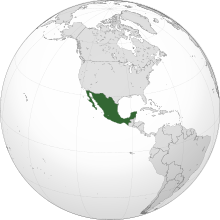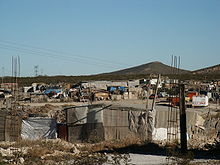
Squatting is the action of occupying an abandoned or unoccupied area of land or a building, usually residential that the squatter does not own, rent or otherwise have lawful permission to use. The United Nations estimated in 2003 that there were one billion slum residents and squatters globally. Squatting occurs worldwide and tends to occur when people find empty buildings or land to occupy for housing. It has a long history, broken down by country below.
In the United States, a colonia is a type of unincorporated, low-income, slum area located along the Mexico–United States border region that emerged with the advent of shanty towns.

Squatting in Spain refers to the occupation of unused or derelict buildings or land without the permission of the owner. In Francoist Spain migrant workers lived in slums on the periphery of cities. During the Spanish transition to democracy, residential squatting occurred in Spanish cities such as Barcelona, Bilbao, Madrid, Valencia and Zaragoza. From the 1980s onwards a new generation of squatters set up self-managed social centres which hosted events and campaigns. The 1995 Criminal Code among other things criminalised squatting, but failed to stop it. Social centres exist across the country and in Barcelona and Madrid in particular. In the Basque Country they are known as gaztetxes.
Squatting in Slovenia is the occupation of derelict buildings or unused land without the permission of the owner. Housing was illegally built from the 1960s onwards and informal settlements have been set up by Romani people or poor immigrants. In the capital Ljubljana, there is the autonomous zone of Metelkova and the Rog self-managed social centre was evicted in early 2021.
Squatting in Uruguay is the occupation of unused or derelict buildings or land without the permission of the owner. In the nineteenth century, pueblos de ratas developed when gauchos were forced to settle by the rural enclosures for cattle farming. In the early twentieth century, European migrant workers lived in conventillos.

Squatting in Peru is the occupation of unused or derelict buildings or land without the permission of the owner. From the 1940s onwards, land invasions created shanty towns which were first called barriadas and later pueblos jóvenes. They were initially repressed, then the government decided upon toleration and by 1998 it was estimated 2.5 million inhabitants were living in this way in the capital Lima. There are also slum tenements in the centre known as solares or tugurios, and a "Wall of Shame" has been built to separate rich and poor areas of the city. During the COVID-19 pandemic, an increase in the occupation of UNESCO World Heritage Sites such as Caral and the Nazca Lines was reported.

Squatting in Guyana is the occupation of unused land or derelict buildings without the permission of the owner. Squatting has been used as a means to find housing by people displaced by conflict in the 1960s and by internal migrants from the 1980s onwards. In 2015, there were estimated to be over 100,000 squatters across the country. The government announced the National Squatter Regularisation Commission (NSRC) and the State Land Resettlement Commission in 2020, in the following year it allied with UN-Habitat to create the Guyana Strategy for Informal Settlements Upgrading and Prevention (GSISUP) which aims to regularize all informal settlements by 2030.

Squatting in Albania began on a large scale in the 1990s after the fall of communism, with internal migration towards formerly collectivised farmland establishing informal settlements. One such area, Bathore on the periphery of the capital Tirana, had 40,000 squatters by the early 2000s who successfully campaigned for better amenities. Other squatters occupied severely polluted post-industrial sites. The Agency of Legalization, Upgrading, and Integration of Informal Zones and Buildings (ALUIZNI) had legalized 16,500 homes on 152 settlements by 2009. As of 2020, 25 per cent of the population of Albania's cities lived in informal settlements.

Squatting in Chile is the occupation of unused land or derelict buildings without the permission of the owner. From the 1960s onwards, informal settlements known as callampas were permitted although there were also evictions such as the massacre of Puerto Montt in 1969. In the 1970s, the government of Salvador Allende encouraged occupations, then following the coup d'état, the military junta repressed squatting. Callampas then became known as campamentos.

Squatting in Pakistan is the occupation of unused land or derelict buildings without the permission of the owner. Squatted informal settlements formed following the creation of Pakistan in 1947. They were known first as "bastis" then later "katchi abadis" and the inhabitants were forcibly resettled under military rule. By 2007, there were 7.5 million squatters in Karachi alone. The Sindh Katchi Abadi Authority (SKAA) announced in 2019 that a total of 1,414 katchi abadis had been located and 1,006 of those had been contacted with regards to beginning a regularization process.

Squatting in Sudan is defined as the "acquisition and construction of land, within the city boundaries for the purpose of housing in contradiction to Urban Planning and Land laws and building regulations." These informal settlements arose in Khartoum from the 1920s onwards, swelling in the 1960s. By the 1980s, the government was clearing settlements in Khartoum and regularizing them elsewhere. It was estimated that in 2015 that were 200,000 squatters in Khartoum, 180,000 in Nyala, 60,000 in Kassala, 70,000 in Port Sudan and 170,000 in Wad Madani.

Squatting in Venezuela is the occupation of derelict buildings or unused land without the permission of the owner. Informal settlements, known first as "ranchos" and then "barrios", are common. In the capital Caracas notable squats have included the 23 de Enero housing estate, Centro Financiero Confinanzas and El Helicoide, a former shopping centre which is now a notorious prison.

Urban areas in the Philippines such as Metro Manila, Metro Cebu, and Metro Davao have large informal settlements. The Philippine Statistics Authority defines a squatter, or alternatively "informal dwellers", as "One who settles on the land of another without title or right or without the owner's consent whether in urban or rural areas". Squatting is criminalized by the Urban Development and Housing Act of 1992, also known as the Lina Law. There have been various attempts to regularize squatter settlements, such as the Zonal Improvement Program and the Community Mortgage Program. In 2018, the Philippine Statistics Authority estimated that out of the country's population of about 106 million, 4.5 million were homeless.

Squatting in Bangladesh occurs when squatters make informal settlements known as "bastees" on the periphery of cities such as Chittagong, Dhaka and Khulna. As of 2013, almost 35 per cent of Bangladesh's urban population lived in informal settlements.
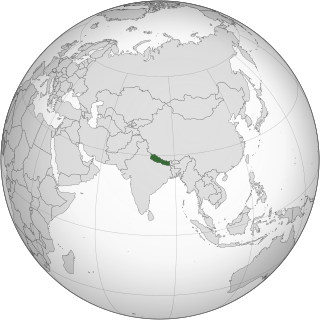
Squatting in Nepal occurs when people live on land or in buildings without the valid land ownership certificate. The number of squatters has increased rapidly since the 1980s, as a result of factors such as internal migration to Kathmandu and two decades of civil war in Nepal. In March 2021, the chairperson of the Commission on Landless Squatters stated that all landless squatters would receive ownership certificates within the following eighteen months.

Squatting in Tunisia is the occupation of derelict land or unused buildings without the permission of the owner. Informal settlements known as "gourbivilles" sprang up in the French protectorate of Tunisia in the 1930s and again after World War II. As French colonialists introduced the concept of private property to nomadic tribes, lawyers such as Habib Bourguiba represented the rights of squatters. By the time Tunisia became an independent republic in 1956, the capital Tunis was ringed by gourbivilles. The response of the authorities was to evict and forcibly resettle.
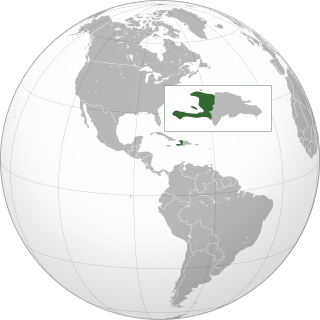
Squatting in Haiti is the occupation of unused land or abandoned buildings without the permission of the owner. Following the Haitian Revolution (1791–1804), squatters acquired smallholdings across the country. As the capital Port-au-Prince grew, so did the informal settlements ringing it. In the Bel Air district, there is some squatting whilst most people pay rent, building their own homes. In 2004, President Jean-Bertrand Aristide was deposed in a coup and poor areas such as Bel Air and Cité Soleil erupted in violence. Peacekeepers from the United Nations Stabilisation Mission in Haiti later evicted ex-combatants squatting in the house of Aristide.
Okupa Che is an anarchist self-managed social centre on the campus of the National Autonomous University of Mexico (UNAM) in Mexico City, Mexico. After the 1999–2000 UNAM strike, participants squatted the Justo Sierra auditorium and offices in the Facultad de Filosofía y Letras on 4 September 2000.

Chanti Ollin was a self-managed social centre in Mexico City, Mexico, between 2003 and 2017. It was occupied in 2003 by students from the 1999–2000 UNAM strike and participants in Okupa Che. It was a derelict five storey building at Calle Melchor Ocampo 424 in Cuauhtémoc. The name means "house in motion" in the Nahuatl language.
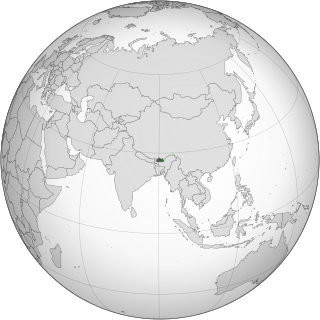
In 2001, about 10 per cent of the population of Bhutan's capital city Thimphu were living in squatted informal settlements; by 2019, the figure had dropped to 2 per cent since the squatters had been rehoused. There are also rudimentary settlements on the periphery of other cities such as Phuntsholing and Samdrup Jongkhar. The inhabitants work as manual labourers or in the informal economy.
